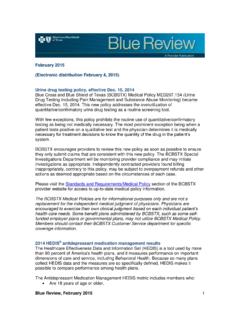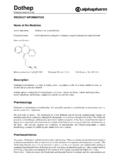Transcription of Data Sheet PROZAC - Medsafe
1 data Sheet PROZAC 20 Fluoxetine hydrochloride. Presentation PROZAC 20 capsules are presented as size 3, green/cream capsules bearing the identicode Lilly 3105 printed in black ink on both the capsule cap and base. Each capsule contains fluoxetine hydrochloride equivalent to 20 mg fluoxetine. Uses Actions PROZAC 20 is an antidepressant intended for oral administration. Fluoxetine is a selective inhibitor of serotonin reuptake, its presumed mechanism of action. Fluoxetine has practically no affinity to other receptors such as 1-, 2- and -adrenergic; serotonergic; dopaminergic; histaminergic; muscarinic; and GABA receptors. Pharmacokinetics Absorption and distribution Fluoxetine is well absorbed after oral administration.
2 Peak plasma concentration is reached in six to eight hours. Fluoxetine is extensively bound to plasma proteins. Fluoxetine is widely distributed. Steady-state plasma concentrations are achieved after dosing for several weeks. Steady-state concentrations after prolonged dosing are similar to concentrations seen at four to five weeks. Metabolism and excretion Fluoxetine is extensively metabolised in the liver to norfluoxetine and a number of other, unidentified metabolites which are excreted in urine. The elimination half-life of fluoxetine is four to six days and that of its active metabolite is four to 16 days. Pharmacological Properties Pharmacodynamic properties - The aetiology of premenstrual dysphoric disorder is unknown, but endogenous steroids (neuro and/or ovarian) involved in the menstrual cycle may interrelate with neuronal serotonergic activity.
3 Clinical data premenstrual dysphoric disorder (PMDD): In clinical trials fluoxetine was shown to be effective in relieving both the cyclical mood changes and physical symptoms (tension, irrritability and dysphoria, bloating and breast tenderness) associated with PMDD. Indications Depression and it s associated anxiety, Bulimia nervosa, Obsessive-Compulsive disorder and Premenstrual dysphoric disorder - a severe form of PMS. Diagnosis of PMDD: The essential features of PMDD are clear and established cyclicity of Page 1 of 11 symptoms (occurring during the last week of the luteal phase in most menstrual cycles) such as depressed mood, anxiety, affective lability, and physical symptoms such as breast tenderness or swelling, headaches, joint or muscle pain, bloating, and weight gain.
4 PMDD is a severe clinical entity and is distinguished from the broader premenstrual syndrome by the intensity of its symptoms (particularly mood symptoms) and the extent to which it interferes with social and/or occupational function. Dosage and Administration Depression 20 mg per day is the recommended initial dose. Bulimia Nervosa 60 mg per day is the recommended dose. Obsessive-Compulsive Disorder 20 mg to 60 mg per day is the recommended dose. Premenstrual Dysphoric Disorder 20 mg per day is recommended continuously throughout the menstrual cycle. Initial treatment should be limited to six months, after which patients should be reassessed regarding the benefit of continued therapy.
5 All Indications The recommended dose may be increased or decreased. Doses above 80 mg/day have not been systematically evaluated. Age There are no data to suggest that alternate dosing is required on the basis of age alone. Use in Children and Adolescents (<18 years) While clinical studies have been conducted in children and adolescents, the use of PROZAC 20 is not recommended in this population. (See Warnings and Precautions Clinical Worsening and Suicide Risk, Impairment of Fertility, Adverse Effects). Administration with Food PROZAC 20 may be administered with or without food. Concurrent Disease and/or Concomitant Medication A lower or less frequent dose should be considered in patients with hepatic impairment, with concurrent diseases, or who are taking multiple medications.
6 Contraindications Hypersensitivity PROZAC 20 is contraindicated in patients known to be hypersensitive to fluoxetine. MAOIs PROZAC 20 should not be used in combination with a monoamine oxidase inhibitor (MAOI) or within a minimum of 14 days of discontinuing treatment with a MAOI. At least five weeks should elapse between discontinuation of PROZAC 20 and initiation of therapy with a MAOI. If PROZAC 20 has been prescribed chronically and/or at a high dose, a longer interval Page 2 of 11 should be considered. Serious and fatal cases of serotonin syndrome (which may resemble and be diagnosed as neuroleptic malignant syndrome) have been reported in patients treated with fluoxetine and a MAOI in close temporal proximity.
7 Warnings and Precautions Warnings Clinical Worsening and Suicide Risk The risk of suicide attempt is inherent in depression and other psychiatric disorders and may persist until significant remission occurs. As with other drugs with similar pharmacological action (antidepressants), isolated cases of suicidal ideation and suicidal behaviors have been reported during fluoxetine therapy or early after treatment discontinuation. This risk must be considered in all depressed patients. Although a causal role for PROZAC in inducing such events has not been established, some analyses from pooled studies of antidepressants in psychiatric disorders found an increased risk for suicidal ideation and/or suicidal behaviours in paediatric and young adult (<25 years of age) patients compared to placebo.
8 Patients with depression may experience worsening of their depressive symptoms and/or the emergence of suicidal ideation and behaviours (suicidality) whether or not they are taking antidepressant medications, and this risk may persist until significant remission occurs. As improvement may not occur during the first few weeks or more of treatment, patients should be closely monitored for clinical worsening and suicidality, especially at the beginning of a course of treatment, or at the time of dose changes, either increases or decreases. Consideration should be given to changing the therapeutic regimen, including possibly discontinuing the medication, in patients whose depression is persistently worse or whose emergent suicidality is severe, abrupt in onset, or was not part of the patient s presenting symptoms.
9 Patients (and caregivers of patients) should be alerted about the need to closely monitor for any worsening of their condition and/or the emergence of suicidal ideation/behaviour or thoughts of harming themselves and to seek medical advice immediately if these symptoms present. Physicians should encourage patients of all ages to report any distressing thoughts or feelings at any time. Patients with co-morbid depression associated with other psychiatric disorders being treated with antidepressants should be similarly observed for clinical worsening and suicidality. Pooled analyses of 24 short-term (4 to 16 weeks), placebo-controlled trials of nine antidepressant medicines [selective serotonin reuptake inhibitors (SSRIs) and others] in 4400 children and adolescents with major depressive disorder (16 trials), obsessive compulsive disorder (4 trials), or other psychiatric disorders (4 trials) have revealed a greater risk of adverse events representing suicidal behaviour or thinking (suicidality) during the first few months of treatment in those receiving antidepressants.
10 The average risk of such events in patients treated with an antidepressant was 4%, compared with 2% of patients given placebo. There was considerable variation in risk among the antidepressants, but there was a tendency towards an increase for almost all antidepressants studied. The risk of suicidality was most consistently observed in the major depressive disorder trials, but there were signals of risk arising from trials in other psychiatric indications (obsessive compulsive disorder and social anxiety disorder) as well. No suicides occurred in these trials. It is unknown whether the suicidality risk in children and adolescent patients extends to use beyond several months. The nine antidepressant medicines in the pooled analyses included five SSRIs (citalopram, fluoxetine, fluvoxamine, paroxetine, sertraline) and four non-SSRIs (bupropion, mirtazapine, nefazodone, venlafaxine).













